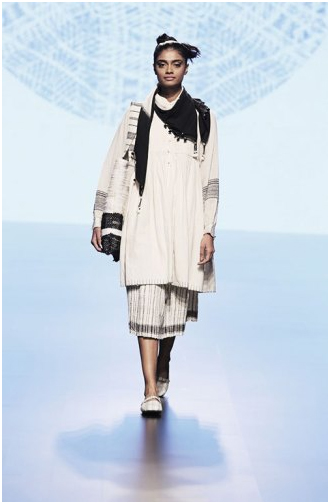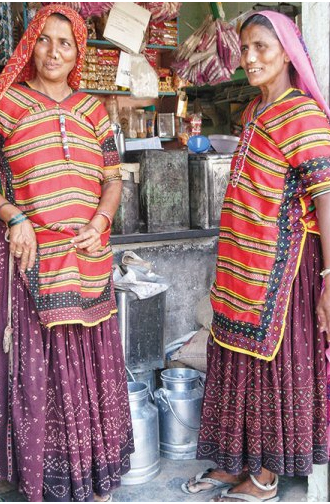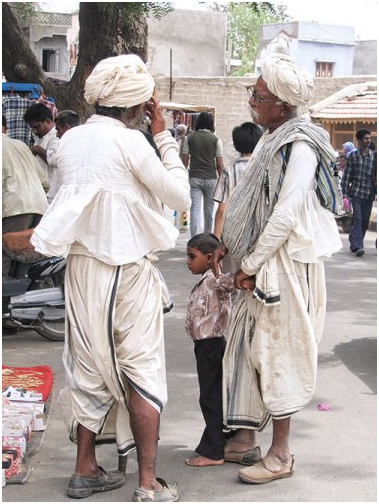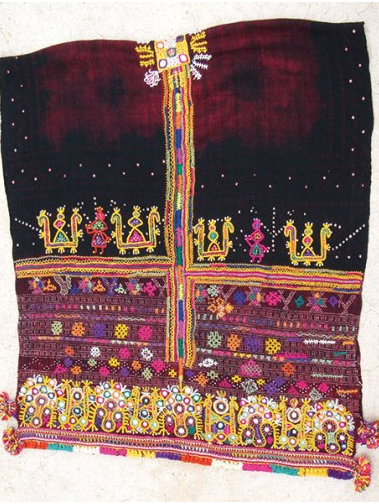
A model at the Ode to Weavers show by Injiri; She is wearing an Injiri organic cotton dress, a khadi skirt and an ikat scarf
In rural and more remote parts of India, dress is still community-specific and defines identity. Traditional folk attire has a strong link to the material techniques prevalent in geographical vicinities. Craft communities are deeply interconnected and interdependent and this is a very important part of the social fabric. The wearer is very aware of this and accustomed to a certain textile and its usage.
In the olden days, people wore what was produced locally, and each community had specific fabrics that were made especially for them in the same or a nearby village. Thus craft was tied to not only the consumption of textiles but also social interaction.
What entices me the most is the combination of spontaneity and classicism in folk dressing. Going deeper into design and the social aspect of locally made materials in India, I have discovered the meaning of slow fashion. I have drawn from not only the aesthetics but the various elements of clothing which are intrinsic to the communal and environmental structure.

An interesting example is the overgarment called goncha that’s worn in Ladakh. Both the men and women’s gonchas are made from handwoven pattus, which are woven by village weavers themselves. The women’s goncha, a narrow-width cloth, is tie-dyed with very bold floral designs, usually by women from one or two households who do this for other families. The tie-dyed pattern is then stitched by hand at home by the wearer herself. The result is a stunning piece. A village called Akola in Rajasthan is also witness to a similar social setup where local dyers serve their communities. Skirts or phentiyas are worn by Jat women in Akola and around nearby villages. Here, several craftsmen print with a gum or mern and resist-dye the skirts for them. The motifs used by the different subgroups depend on which village the Jats are from. Even though a lot of the handmade textiles are replaced with mill-produced imitations now, a small population of the older generation still uses locally made fabrics. And the artisans who previously served the communities have expanded their product range to suit the modern urban consumer in order to sustain themselves.
Folk attire is not only an expression of group identity but is also utilitarian and suits the lifestyle of communities whose livelihoods are connected to nature. Similarly, clothes worn by farmers and peasants in other parts of the world — for example, English smocks — employ a lot of gathering, pleating and smocking. By making it voluminous, it becomes strong enough to withstand all the abrasion of the fields. Many antique garments were also panelled owing to narrow widths of handwoven yardages.

The skirts of Rabari women in Gujarat and Jats in Rajasthan are made of thicker material and gathered at the waist. This allows them to move around in their desert environs without much wear and tear. Similarly, the upper garment worn by men, the kediyu, has dense gathers at the yoke, making it strong enough to withstand strenuous physical work like tending to livestock. The unstitched lower garment is draped in many different ways to allow for flexibility of movement. The shoulder cloth is multipurpose, it can be used as a spread to sleep on or tied up to carry objects.
Along with their use of craft what is most inspiring is the innate sense of style. At the outset, a group of Jats or Rabaris may seem like a monochromatic lot, but on closer look you realise how functionality and group identity are woven together. And in spite of the similarity of its purpose when you delve into their dress, you can see how they reflect personality. One can see how effortlessly a Rabari women carries herself in her stunning black outfit — a pernu (draped bottoms), a blouse with beautiful contrast stitch and hand embroidery (although the handloom fabrics in many cases are replaced by polyester), combined with woollen lodhkis (that are still produced for them by the local Khatri dyers as mentioned earlier).
This is slow fashion in the real sense; sustainability expressed without much effort and through deep interconnectedness; where one respects the traditions, nature and surrounding resources, appreciates the process of making one’s own textiles and clothes, and the entire cycle that they pass through.

Women's head shawl, woven by Vankars in Gujarat's Adhoi village, dyed in the nearby Chaubari village by Khatri artisans and embroidered by Bharwad Rabaris of Vagad
One can’t ignore the element of classicism in traditional clothing; there is something timeless and aesthetically pleasing to so many people. And the other most important aspect is the spontaneity in the process of making these garments. Both derive from their being ‘handmade’ in the real sense. And the same is true across the world. Smocks were made at home or by a local seamstress, at a time when producing clothes was a very slow process, allowing the maker to create each piece at leisure; when woven material was a precious commodity used frugally. The handmade quality is very evident, and I am inspired by it over and over again.
Very often, these old smocks will have the initials of its owner embroidered onto them, just as the embroidered motif on a Rabari veil depicts the community she comes from. Or the embroidery on a kediyu indicates the subgroup that the man belongs to.



















Your Message